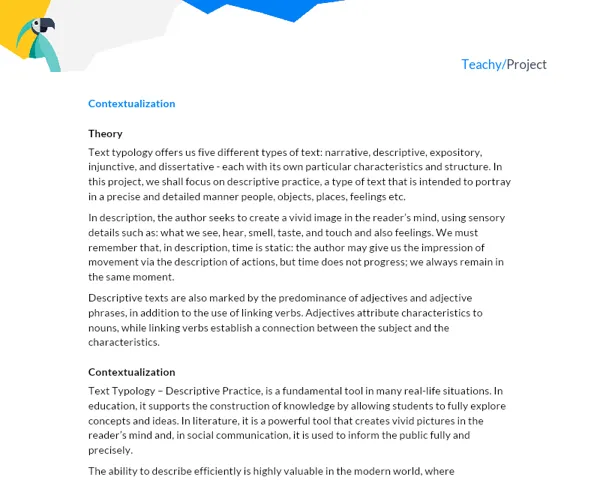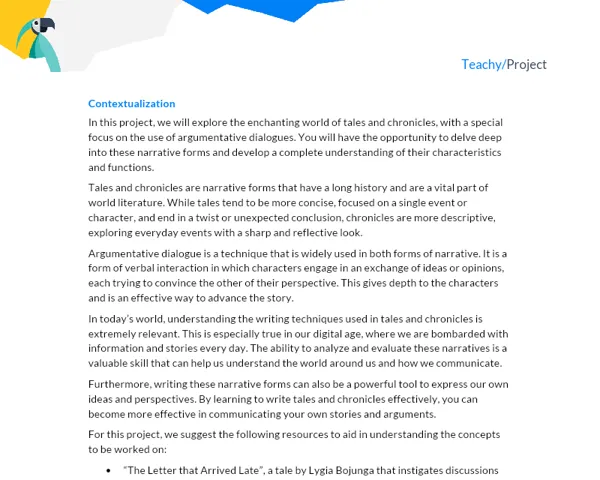Introduction
Text interpretation is an essential skill for understanding any discipline, as it allows individuals to absorb the knowledge contained in texts and express it. Nevertheless, it is crucial for everyday life, from reading basic instructions to understanding complex news.
The interpretation of text is based on several key theoretical concepts, ranging from understanding the topic addressed, identifying main and secondary ideas and distinguishing between facts and opinions, to the ability to make correct inferences and evaluate the author's intention and tone.
In addition, text interpretation demands critical reading skills. This means that you need to question what you are reading, putting yourself in the author's shoes to understand their intentions and perspectives. With this questioning process, the reader is able to reach a deeper understanding of the text.
Contextualization
In a world increasingly full of information and news, knowing how to interpret a text is an even more valuable skill. We understand that this ability is not developed solely through reading, but also through practice and discussion on various textual themes.
In addition, the interpretation of text has an indisputable value in the formation of a conscious, questioning and critical citizen. Learning to interpret a text adequately is acquiring the ability to evaluate arguments, identify prejudices or fallacies and formulate well-founded opinions of one's own.
To deepen your knowledge on the subject, we recommend the following resources:
-
How to Read Books: This book provides valuable guidance on how to improve your reading and interpretation skills.
-
TED Talk: 5 Techniques to Improve Your Reading Skills: In this lecture, the speaker presents practical methods to improve reading and text interpretation.
-
Khan Academy: Here you will find a series of videos and interactive exercises to help you understand the fundamental elements in the construction of a text.
Practical Activity
Title of Activity: Text Detectives
Objective of Project
The main objective of this project is to improve students' ability to interpret and analyze texts in a critical and collaborative way. To this end, we will do a series of activities that will challenge students to work together, share ideas, make inferences and solve problems related to textual interpretation.
Detailed Description of the Project
The "Text Detectives" project will be carried out in groups of 3 to 5 students. Each group will receive a set of texts of different genres and styles, such as news, blogs, academic articles, poems, narratives, among others. These texts will be analyzed by the groups using collaborative annotation tools, such as Google Docs.
Students will have to decipher the meaning of the text, identify the main, secondary and implicit ideas, discern between facts and opinions and infer the author's intentions and tone. In some cases, they will have to identify errors or distortions and explain how that affects the interpretation of the text. In addition, they must also apply critical reading to question the text and the ideas presented by the author.
In addition to Portuguese, the project will also involve elements of the discipline of History. Understanding the historical context in which a text is written is crucial for its interpretation.
The project will last two weeks, enough time for each member of the group to dedicate more than twelve hours to the project.
Necessary Materials
- Various texts of different genres and styles for analysis.
- Collaborative annotation tools (ex: Google Docs).
- Portuguese and History books for consultation.
- Internet access for research.
Step-by-Step
-
Group and text selection: Students group together and receive the texts they will analyze.
-
Initial Reading: Students read the text independently and make their first annotations.
-
Group Discussion: Students meet and discuss their interpretations, difficulties and doubts about the text.
-
Research and Study: Students research the text, the author, the historical context and other elements that may help in the interpretation.
-
Group Analysis: Based on the research, the students meet again to do a deeper analysis of the text and consolidate their interpretations.
-
Report Writing: Students write a detailed report on the text interpretation process, including the difficulties encountered, the strategies used, the insights gained and the conclusions reached.
The report should be structured in the following main topics: Introduction, Development, Conclusions and Bibliography.
Project Delivery and how it connects to the suggested activities
At the end of the project, students must deliver the report with the complete analysis of each text. This document is a representation of the entire process experienced during the project, detailing all the methodology applied, from the initial reading to the conclusion of the interpretation of the texts.
In the Introduction, students should present the context and objective of the project, briefly introduce the texts chosen for analysis and explain the relevance of textual interpretation in everyday life and in the school environment.
The Development should contain the theory applied in the interpretation of the texts, the detailed explanation of the strategies used for the interpretation, the description of the activities carried out and the discussion of the results obtained.
In the Conclusions, students should return to the main points of the report, highlight what they learned, what challenges were encountered and the solutions applied, and finally present a final conclusion on textual interpretation and teamwork.
The Bibliography should be complete and careful, listing all the sources used during the project, both for the analysis of the texts and for the theoretical and explanatory part of the report.



